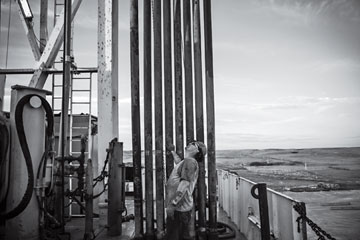
Fracking has unlocked new oil supplies in states like North Dakota, reducing crude imports.
(3 of 6)
The fracking boom spread first from Texas to Louisiana and Oklahoma and then to Pennsylvania, which essentially went from zero to 60 on gas drilling in just a few years. From 2006 to 2012, U.S. production of natural gas increased by 30%, to more than 25 trillion cu. ft. a year. The price of natural gas fell by some 50%, which allowed utilities--preparing to meet tougher air-pollution rules from the Environmental Protection Agency (EPA)--to replace older coal plants with cleaner gas-fired facilities. Coal went from providing 50% of U.S. electricity generation in 2007 to 37% in 2012. Those terminals that were being built just a few years ago to process imported LNG? They're now being retrofitted to export excess American LNG, which will sell overseas for much less than what it takes countries like China to produce it.
Meanwhile, with oil prices soaring through the 2000s, the same breed of wildcatters who led the way by fracking for gas were ready to try fracking for crude in the vast Bakken shale formation in western North Dakota. In 1995 the U.S. Geological Survey (USGS) took a look at the Bakken shale field that runs from Saskatchewan to South Dakota and estimated that it held just 151 million barrels of undiscovered "technically recoverable" oil. Technically recoverable means crude that is drillable using current technologies, and with the technologies of 1995, when a barrel cost only about $27, the oil in the Bakken field might as well have been on the moon.
But fracking and directional drilling changed the equation, and in 2008 the USGS raised the technically recoverable estimates in the Bakken up to 3 billion to 4.5 billion barrels. Oil production in the state rose from about 36,000 barrels a day at the start of 2008 to 810,000 a day in July of this year. Now North Dakota has the lowest unemployment rate in the country; its state budget surplus is projected to hit nearly $1.6 billion over the next two years. On nighttime satellite images of the U.S., rural western North Dakota is lit up nearly as brightly as Chicago--because of hundreds of oil rigs flaring off excess natural gas.
Partly as a result, domestic oil production hit 7.75 million barrels a day in September, the highest level since 1989, while oil imports are at 7.5 million barrels a day and falling. Earlier this year, the U.S. became a net exporter of oil distillates, and the International Energy Agency projects that the U.S. could be almost energy self-sufficient in net terms by 2035. The country that was spending $341 billion on crude-oil imports in 2008 managed to export $117 billion worth of processed oil products in 2012. That's a lot of money that is staying in the U.S. "This is a transformational phenomenon," says Leonardo Maugeri, an associate at the Harvard Kennedy School's Belfer Center for Science and International Affairs.
